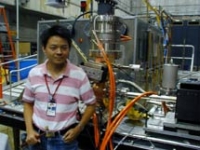 |
 |
|||||||||||||
|
|||||||||||||
|
|||||||||||||
|
While other labs concentrate on developing superconducting cavities for the International Linear Collider (ILC), SLAC is focusing on the technology needed to power them. In addition to klystron, modulator and radio frequency (RF) distribution development, this effort includes a coupler program. A coupler is basically a coaxial transmission line that connects normal-conducting, air-filled, room-temperature waveguides to each superconducting, evacuated, super-cold accelerator cavity. The couplers are complex devices due to the various requirements imposed on them; they must convert the RF to a coaxial mode, transmit high power (~300 kW), be mechanically flexible for cool-down of one end to 2K (-271° Celsius), have a moveable center conductor, have two windows for redundant vacuum isolation, and be as particulate free as the extremely clean cavities. The SLAC coupler programme, headed by Chris Adolphsen of the ILC Department with collaboration from Brian Rusnak of Lawrence Livermore National Laboratory, has two parts. The first is a series of experiments aimed at understanding how the various coupler pieces impact the RF processing time it takes to reach full power operation with acceptable vacuum. It is hoped that isolating parts and studying the limiting phenomena, such as outgassing, will lead to design improvements. To this end, a test stand has been built in End Station B, powered by an L-band (1.3 GHz) klystron. It includes two specially designed waveguide-to-coax adaptors between which various test pieces will be installed. The latter are two-foot long tubes with different surface preparations or features, such as bellows. A copper inner conductor is supported inside these. Two large RF windows separate the experimental region from the pressurised input waveguide and load for operation under vacuum. During processing, various signals (RF, electron, pressure, and light) are recorded as the power is increased step-wise in amplitude and pulse width. Results so far with straight stainless steel tubes show a resonant phenomenon known as multipacting, in which electrons repeatedly hit the wall, producing more electrons on each impact. This resonant growth occurs only at certain power levels, and the data show fair agreement with predictions. The other part of the coupler programme involves assembilng and processing couplers for the ILC-like cryomodules that are being assembled at Fermilab in the foreseeable future. For this effort, an ultrasonic bath and a class 10 clean-room (10 particles/ft3 above half a micron) will be installed in Building 6, where assembly of the many coupler parts will take place. After painstaking preparation and assembly, the couplers will be mounted in pairs on a specially designed processing cavity in a support stand. They will then be RF processed (warm), with high power flowing into the processing cavity through one coupler and out through the other, until full power is achieved at an acceptable vacuum level. Processed couplers will be shipped to Fermilab, at a rate of roughly 30 per year, where they will be connected to accelerator cavities. The SLAC effort to assemble and process couplers for FNAL parallels that at LAL Orsay in support of the DESY cavity programme. At SLAC, we have learned much from their extensive experience and plan to continue a close working relation with them and the SRF group at KEK to develop low cost, high quality couplers for the ILC. There will be a NewsLine story on the Orsay coupler efforts soon. -- Christopher Nantista |
|||||||||||||
| © International Linear Collider |
